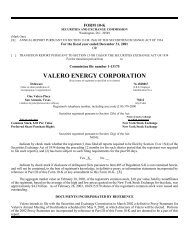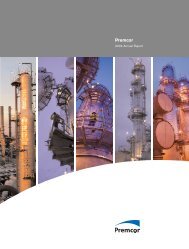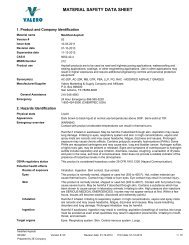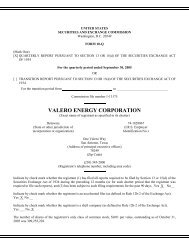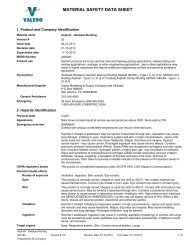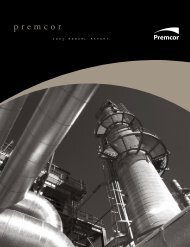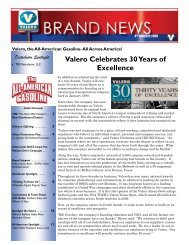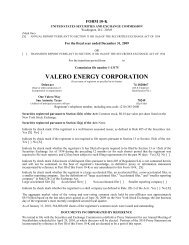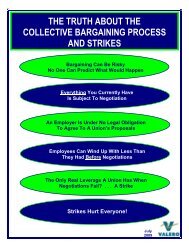Excellence Refined - 30 Years - Valero
Excellence Refined - 30 Years - Valero
Excellence Refined - 30 Years - Valero
Create successful ePaper yourself
Turn your PDF publications into a flip-book with our unique Google optimized e-Paper software.
The centerpiece of the “Refinery<br />
of the Future” would be the<br />
Heavy Oil Cracker, cutting edge<br />
technology in the early 1980s.<br />
state-of-the-art operation was no small task, and an<br />
uncertain economy was no help. But <strong>Valero</strong> forged<br />
ahead with a 33-month, $535 million construction plan<br />
to build the “Refinery of the Future.” The plant’s new<br />
heavy oil cracker, with the ability to convert high-sulfur<br />
residual oil (resid) into premium products, would add<br />
an important element to <strong>Valero</strong>’s plan to diversify. As<br />
one Saber executive put it at the time: “Everything is<br />
mammoth in this refinery.”<br />
<strong>Valero</strong> set out to build a world-class plant that would<br />
be unique in two respects – the production of 100<br />
percent unleaded gasoline, and the processing of resid<br />
rather than conventional sweet crude. By taking on<br />
the most difficult-to-process feedstock – which sold<br />
at a significant discount to light sweet crude – the<br />
company could achieve higher refining margins than a<br />
conventional refiner. At the time of construction, the<br />
refinery’s heavy oil cracker was one of only three such<br />
units in the world. Beyond its sparkling new assets,<br />
<strong>Valero</strong>’s first refinery also gained prominence for<br />
environmental excellence and energy efficiency – two<br />
priorities still at the heart of the company’s operation.<br />
Longtime Gulf Oil executive Martin Zanotti joined the<br />
<strong>Valero</strong> team to help free the refinery from management<br />
problems and operational snags. Zanotti ultimately was<br />
named Executive Vice President of <strong>Valero</strong> Refining and<br />
Marketing Company. Upon his retirement from <strong>Valero</strong><br />
in 1995, Zanotti reminisced about the challenges for<br />
<strong>Valero</strong> in its early days. With the expertise of engineers<br />
such as John Hohnholt, who went on to serve as Vice<br />
President and General Manager of the Corpus Christi<br />
Refinery and a senior corporate executive before his<br />
death in 2004, the refinery was ahead of its time in<br />
technology. But few at the plant had the expertise to<br />
make the concept work. “We put the refinery on the<br />
right road. And that took a lot of effort on everybody’s<br />
part,” Zanotti said. “<strong>Valero</strong> turned out to be even more<br />
of an exciting challenge than I had expected.”<br />
With a state-of-the-art refinery as its flagship, <strong>Valero</strong><br />
continued to field criticism for its faith in the industry.<br />
News articles and magazines portrayed a company<br />
drowning in debt, with no way to escape. “Even if <strong>Valero</strong><br />
wanted to,” one article read, “it would have a difficult<br />
A Company Is Born<br />
8





